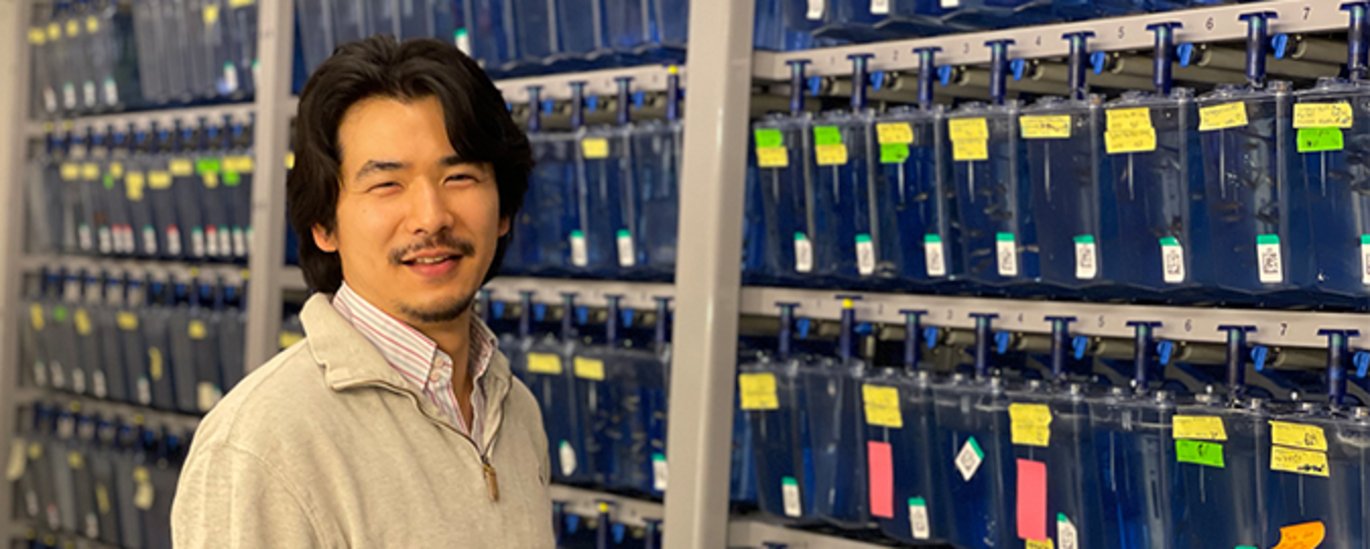Yuya Hayashi receives a Hallas-Møller Emerging Investigator grant from the Novo Nordisk Foundation
Yuya Hayashi has been awarded DKK 10 million (EUR 1,3 million) from the Novo Nordisk Foundation over the next five years to start up his own research group at the Department of Molecular Biology and Genetics, Aarhus University. The aim of his research is to redefine our understanding of how life operates through cell-to-cell communication by studying extracellular vesicles, a poorly characterised family of messengers. He will use zebrafish as a model organism for visualisation of such biological processes and an RNA origami technology to manipulate the conversation between cells.

Extracellular vesicles were once believed to be just waste shed from cells. Today, our understanding of these vesicles is a lot deeper – they actually have many origins and respective roles in all multicellular forms of life. For example, extracellular vesicles can relay various types of information from one cell to another over a long distance, like hormones, but in a more complicated manner than signalling.
We dream of novel inspirations from those small bags filled with mysteries, yet much remains unknown about the very basic of their biology. How do they find their destination through the bloodstream? What messages are conveyed? Can we use the knowledge to manipulate the communication between cells? Assistant Professor Yuya Hayashi will tackle these challenging questions in the next five years together with two PhD students.
"It was great news that came out of the blue, when I was being away from work on parental leave and busy changing the nappy of my baby girl," says Yuya. "I am very happy to be given the fantastic opportunity for challenging hot topics that are still full of unknowns. The project is highly interdisciplinary, and I am extremely excited to push the boundary of my research by starting new collaborations with experts across different fields."
A quest starring zebrafish as a model for bionanoscience research
Yuya completed a five-year PhD programme at Interdisciplinary Nanoscience Center (iNANO), Aarhus University (AU). Back then, his "pet" animals were earthworms that allowed him to study primitive immune responses towards engineered nanoparticles, where possible, with reference to human immune cells. Switching to zebrafish, he started his own quest through two consecutive postdoctoral grants from the Independent Research Fund Denmark and the Lundbeck Foundation. He first learnt about cutting-edge zebrafish research at Karlsruhe Institute of Technology (KIT), Germany, and then established a zebrafish model for bioimaging of nanoparticles at the Department of Molecular Biology and Genetics (MBG), AU.
Links to the news articles on the fruits of these studies
- Zebrafish lets you see the biological fate of nanoparticles in vivo
- Zebrafish embryos help prove what happens to nanoparticles in the blood
"My research so far has focused on how immune systems respond to synthetic nanoparticles injected into the blood. But then I found out similarities between those nanoparticles and extracellular vesicles in the way they behave once inside the bloodstream," says Yuya.
"It was at this point when my journey took a new exciting path, thanks to a Lundbeck Foundation Experiment grant that has allowed me to develop a breakthrough method for studying extracellular vesicles in zebrafish."
A zebrafish approach to two big challenges
The new project will combine his latest work on extracellular vesicles and emerging nanotechnology called "RNA origami". What connects these two is RNA interference, an important biological process for regulating gene expression. Extracellular vesicles are believed to have the ability for delivering regulatory RNA as a mode of communication between cells. This process will be mimicked by targeted delivery of such RNA molecules using the RNA origami technology.
"This project has many planned collaborations within the university and across Europe. But among those, I would like to emphasise the support from Dr. Ebbe Sloth Andersen and Prof. Jørgen Kjems (MBG/iNANO) who will help me with RNA origami," says Yuya.
He continues: "RNA origami is a nascent technology born at iNANO, and I am very much interested in its application in living organisms – it gives an opportunity to gain novel insights into how immune systems work against artificial RNA structures. Nature has devised means to combat virus, for example, through recognition of foreign DNA and RNA molecules within a cell. Why is RNA delivered via extracellular vesicles free from antiviral immunity? Is there a privileged pathway for extracellular vesicles to release the cargo into the cell unscathed?
Yuya's research group will seek answers to the meaning of extracellular vesicles in RNA communication and how it can be exploited for biomedicine without alarming antiviral immunity. Zebrafish will play the central role as a model organism through the power of imaging and genetic approaches. He believes successful outcome of this project will hold the promise to redefine our understanding of how life operates through communication between cells.
The zebrafish facility at MBG
Yuya's research has been assisted by the zebrafish facility, headed by Dr. Kasper Kjær-Sørensen and Prof. Claus Oxvig at MBG, AU. Correspondence regarding the use of the facility should be made to Kasper (kks@mbg.au.dk) or Claus (co@mbg.au.dk).
For further information, please contact
Assistant Professor Yuya Hayashi
Department of Molecular Biology and Genetics
Aarhus University, Denmark
yuya.hayashi@mbg.au.dk
Group webpage:
https://mbg.au.dk/yuya-hayashi/
Twitter:
@NanoBIaS_Yuya
